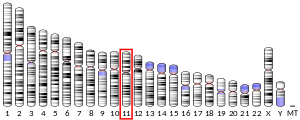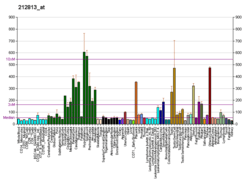JAM3
Junctional adhesion molecule C is a protein that in humans is encoded by the JAM3 gene.[5]
Gene
This gene is located on the long arm of chromosome 11 (11q25) on the Watson strand. It is 83,077 bases in length. The encoded protein is 310 amino acids long with a predicted molecular weight of 35.02 kiloDaltons.
Function
Tight junctions represent one mode of cell-to-cell adhesion in epithelial or endothelial cell sheets, forming continuous seals around cells and serving as a physical barrier to prevent solutes and water from passing freely through the paracellular space. The protein encoded by this immunoglobulin superfamily gene member is localized in the tight junctions between high endothelial cells. Unlike other proteins in this family, this protein is unable to adhere to leukocyte cell lines and only forms weak homotypic interactions. The encoded protein is a member of the junctional adhesion molecule protein family and acts as a receptor for another member of this family.[5]
Clinical significance
Loss-of-function mutations in this gene cause a rare syndrome - autosomal recessive hemorrhagic destruction of the brain, subependymal calcification and congenital cataracts.[7]
References
- GRCh38: Ensembl release 89: ENSG00000166086 - Ensembl, May 2017
- GRCm38: Ensembl release 89: ENSMUSG00000031990 - Ensembl, May 2017
- "Human PubMed Reference:". National Center for Biotechnology Information, U.S. National Library of Medicine.
- "Mouse PubMed Reference:". National Center for Biotechnology Information, U.S. National Library of Medicine.
- "Entrez Gene: JAM3 junctional adhesion molecule 3".
- Ebnet K, Aurrand-Lions M, Kuhn A, Kiefer F, Butz S, Zander K, Meyer zu Brickwedde MK, Suzuki A, Imhof BA, Vestweber D (October 2003). "The junctional adhesion molecule (JAM) family members JAM-2 and JAM-3 associate with the cell polarity protein PAR-3: a possible role for JAMs in endothelial cell polarity". J. Cell Sci. 116 (Pt 19): 3879–91. doi:10.1242/jcs.00704. PMID 12953056.
- Akawi NA, Canpolat FE, White SM, Quilis-Esquerra J, Sanchez MM, Gamundi MJ, Mochida GH, Walsh CA, Ali BR, Al-Gazali L (December 2012). "Delineation of the Clinical, Molecular and Cellular Aspects of Novel JAM3 Mutations Underlying the Autosomal Recessive Hemorrhagic Destruction of the Brain, Subependymal Calcification and Congenital Cataracts". Hum. Mutat. 34 (3): 498–505. doi:10.1002/humu.22263. PMC 3951164. PMID 23255084.
Further reading
- Muller WA (2003). "Leukocyte-endothelial-cell interactions in leukocyte transmigration and the inflammatory response". Trends Immunol. 24 (6): 327–34. doi:10.1016/S1471-4906(03)00117-0. PMID 12810109.
- Maruyama K, Sugano S (1994). "Oligo-capping: a simple method to replace the cap structure of eukaryotic mRNAs with oligoribonucleotides". Gene. 138 (1–2): 171–4. doi:10.1016/0378-1119(94)90802-8. PMID 8125298.
- Suzuki Y, Yoshitomo-Nakagawa K, Maruyama K, et al. (1997). "Construction and characterization of a full length-enriched and a 5'-end-enriched cDNA library". Gene. 200 (1–2): 149–56. doi:10.1016/S0378-1119(97)00411-3. PMID 9373149.
- Arrate MP, Rodriguez JM, Tran TM, et al. (2002). "Cloning of human junctional adhesion molecule 3 (JAM3) and its identification as the JAM2 counter-receptor". J. Biol. Chem. 276 (49): 45826–32. doi:10.1074/jbc.M105972200. PMID 11590146.
- Aurrand-Lions M, Johnson-Leger C, Wong C, et al. (2002). "Heterogeneity of endothelial junctions is reflected by differential expression and specific subcellular localization of the three JAM family members". Blood. 98 (13): 3699–707. doi:10.1182/blood.V98.13.3699. PMID 11739175.
- Liang TW, Chiu HH, Gurney A, et al. (2002). "Vascular endothelial-junctional adhesion molecule (VE-JAM)/JAM 2 interacts with T, NK, and dendritic cells through JAM 3". J. Immunol. 168 (4): 1618–26. doi:10.4049/jimmunol.168.4.1618. PMID 11823489.
- Phillips HM, Renforth GL, Spalluto C, et al. (2002). "Narrowing the critical region within 11q24-qter for hypoplastic left heart and identification of a candidate gene, JAM3, expressed during cardiogenesis". Genomics. 79 (4): 475–8. doi:10.1006/geno.2002.6742. PMID 11944976.
- Cunningham SA, Rodriguez JM, Arrate MP, et al. (2002). "JAM2 interacts with alpha4beta1. Facilitation by JAM3". J. Biol. Chem. 277 (31): 27589–92. doi:10.1074/jbc.C200331200. PMID 12070135.
- Santoso S, Sachs UJ, Kroll H, et al. (2002). "The junctional adhesion molecule 3 (JAM-3) on human platelets is a counterreceptor for the leukocyte integrin Mac-1". J. Exp. Med. 196 (5): 679–91. doi:10.1084/jem.20020267. PMC 2194005. PMID 12208882.
- Strausberg RL, Feingold EA, Grouse LH, et al. (2003). "Generation and initial analysis of more than 15,000 full-length human and mouse cDNA sequences". Proc. Natl. Acad. Sci. U.S.A. 99 (26): 16899–903. doi:10.1073/pnas.242603899. PMC 139241. PMID 12477932.
- Ebnet K, Aurrand-Lions M, Kuhn A, et al. (2004). "The junctional adhesion molecule (JAM) family members JAM-2 and JAM-3 associate with the cell polarity protein PAR-3: a possible role for JAMs in endothelial cell polarity". J. Cell Sci. 116 (Pt 19): 3879–91. doi:10.1242/jcs.00704. PMID 12953056.
- Clark HF, Gurney AL, Abaya E, et al. (2003). "The secreted protein discovery initiative (SPDI), a large-scale effort to identify novel human secreted and transmembrane proteins: a bioinformatics assessment". Genome Res. 13 (10): 2265–70. doi:10.1101/gr.1293003. PMC 403697. PMID 12975309.
- Ota T, Suzuki Y, Nishikawa T, et al. (2004). "Complete sequencing and characterization of 21,243 full-length human cDNAs". Nat. Genet. 36 (1): 40–5. doi:10.1038/ng1285. PMID 14702039.
- Zen K, Babbin BA, Liu Y, et al. (2005). "JAM-C is a component of desmosomes and a ligand for CD11b/CD18-mediated neutrophil transepithelial migration". Mol. Biol. Cell. 15 (8): 3926–37. doi:10.1091/mbc.E04-04-0317. PMC 491847. PMID 15194813.
- Zhang Z, Henzel WJ (2005). "Signal peptide prediction based on analysis of experimentally verified cleavage sites". Protein Sci. 13 (10): 2819–24. doi:10.1110/ps.04682504. PMC 2286551. PMID 15340161.
- Chavakis T, Keiper T, Matz-Westphal R, et al. (2005). "The junctional adhesion molecule-C promotes neutrophil transendothelial migration in vitro and in vivo". J. Biol. Chem. 279 (53): 55602–8. doi:10.1074/jbc.M404676200. PMID 15485832.
- Gerhard DS, Wagner L, Feingold EA, et al. (2004). "The status, quality, and expansion of the NIH full-length cDNA project: the Mammalian Gene Collection (MGC)". Genome Res. 14 (10B): 2121–7. doi:10.1101/gr.2596504. PMC 528928. PMID 15489334.
- Aurrand-Lions M, Lamagna C, Dangerfield JP, et al. (2005). "Junctional adhesion molecule-C regulates the early influx of leukocytes into tissues during inflammation". J. Immunol. 174 (10): 6406–15. doi:10.4049/jimmunol.174.10.6406. PMID 15879142.
- Santoso S, Orlova VV, Song K, et al. (2006). "The homophilic binding of junctional adhesion molecule-C mediates tumor cell-endothelial cell interactions". J. Biol. Chem. 280 (43): 36326–33. doi:10.1074/jbc.M505059200. PMID 16118203.





